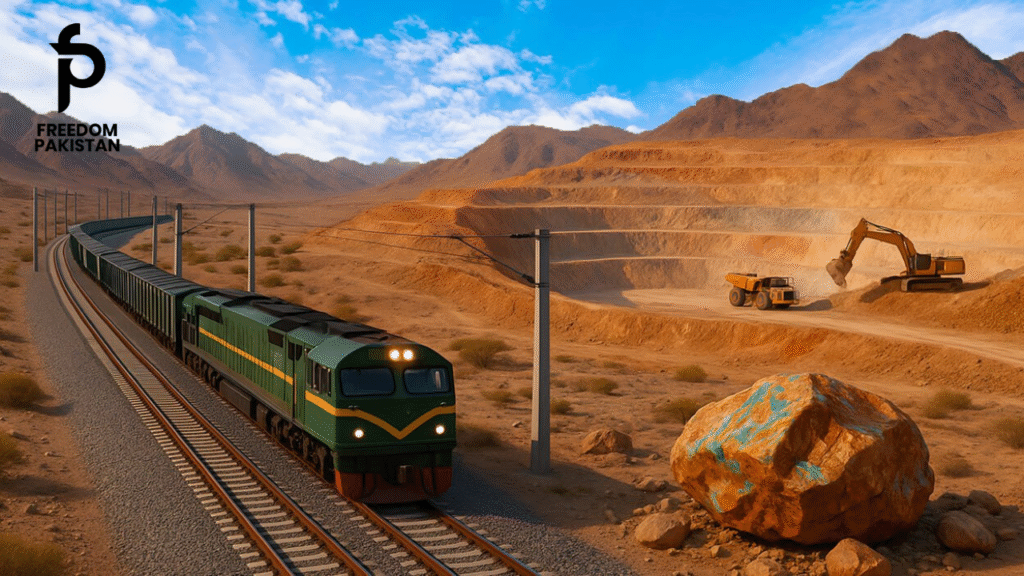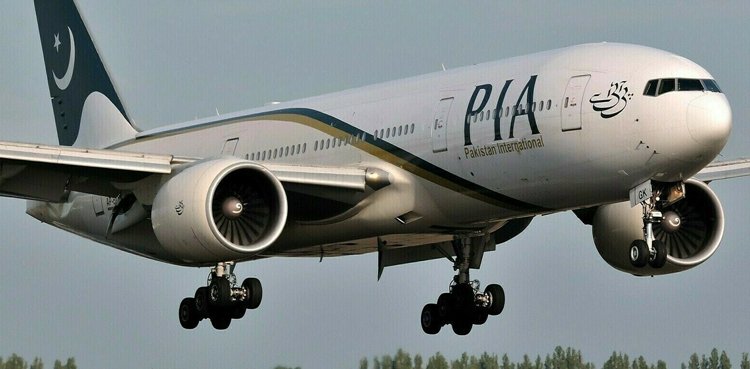Prime Minister Shehbaz Sharif has directed the initiation of a railway connection to the Reko Diq mining site in Balochistan—a move expected to simplify mineral transport, catalyse regional development, and strengthen Pakistan’s mineral infrastructure.
Introduction
Prime Minister Shehbaz Sharif has issued a pivotal directive to connect Pakistan’s largest undeveloped copper‑gold mine, Reko Diq, in Balochistan, to the national railway network. This strategic directive aligns with Pakistan’s ongoing efforts to turn mineral wealth into economic growth, enhancing connectivity and lowering transport costs. By linking Reko Diq to rail, the government aims to streamline logistics, facilitate exports via ports, and support socio-economic uplift in one of the country’s most underserved regions.
What Is Reko Diq?
Nestled in the Chagai District of southwestern Balochistan, the Reko Diq mine stands among the world’s largest untapped copper‑gold deposits. Estimates suggest 5.9 billion tonnes of ore, averaging 0.41% copper and 41.5 million oz of gold, with a projected mine life of at least 40–80 years Developed by Barrick Gold, in partnership with Pakistan and Balochistan governments, the project is expected to produce 200,000 t of copper annually in phase one, with gold outputs and expanded throughput.
The total investment is currently estimated at $6.6–6.8 billion for the first phase, rising from initial projections of around $4 billion. Funding is provided by a consortium including IFC, ADB, U.S. EXIM Bank, and JBIC.
The Government’s New Railway Vision
PM Shehbaz Sharif has ordered authorities to prepare a provisional plan exploring road and railway networks from Reko Diq to Gwadar and Port Qasim. The plan includes:
-
Rail spur: A branch line from Noukandi to Reko Diq, connecting to existing ML1/ML3 tracks toward Port Qasim or Gwadar.
-
Logistical feasibility: Studies by RDMC consultants and Pakistan Railway to assess capacity, rolling stock, and gradients
-
Port options: Analysis favours Port Qasim initially due to bulk terminal limitations at Gwadar; future plans consider Gwadar to reduce distance .
These governmental directives underscore a comprehensive infrastructure agenda, integrating rail and road upgrades, security measures, and environmental assessments.
Economic and Strategic Importance of the Railway Link
a. Reduced Logistical Costs
Transport by rail dramatically lowers per-ton costs compared to road transport, which is costlier, slower, and prone to wear and tear—factors exacerbated by the steep and remote terrain around Reko Diq.
b. Faster Mineral Export
A direct rail route would link Reko Diq to export hubs like Gwadar or Port Qasim, accelerating maritime shipments. This reduces travel times and operating costs, while supporting export diversification.
c. Spur for Foreign Exchange Earnings
With an output potential of $74 billion in free cash flow over 37 years, as forecast by Barrick’s CEO, infrastructure investment is critical to unlocking these gains.
d. Boost to National Infrastructure
Rail connectivity complements broader infrastructure goals under CPEC and Pakistan Railways modernization efforts, enhancing freight capabilities nationwide.
Regional Development and Local Benefits
a. Local Employment Growth
Construction and railway operations are expected to create thousands of direct and indirect jobs, with RDMC estimating 7,500 jobs during peak construction and 4,000 long-term positions.
b. Economic Integration in Balochistan
Rail access will enable smaller towns along the corridor to benefit through job opportunities, commuter travel, and support industries.
c. Social Progress
Plans include humane security, environmental and social impact assessments, and stakeholder consultations—aiming to equitably distribute benefits within the region .
d. Regional Stability
Greater public participation and visible development efforts can reduce insurgency risks in Chagai and surrounding districts.
Environmental and Security Considerations
a. Environmental Impact Assessments
PM Sharif directed accelerated work on environmental and social impact studies, with full Railway feasibility scheduled by end of the year.
b. Security Protocols
Fool proof security for rail workers, equipment, and cargo is mandated given the region’s sensitivity; coordination with local law enforcement will follow established road operation protocols.
c. Infrastructure Resilience
Terrain challenges—like steep grades on ML3—require specialized railway solutions, updated rolling stock, and track reinforcement.
Timeline, Funding, and International Collaboration
a. Funding Arrangements
-
IFC has committed $400 million (total $700M)
-
Larger financing includes over $2 billion from IFC, IDA, EXIM, ADB, JBIC
-
Railway infrastructure finance is pegged at $500–800 million, with an initial $350 million portion.
b. Project Timeline
-
Technical feasibility and financing term sheets expected by Q3 2025
-
Railway planning and feasibility to be completed by year’s end, as per PM directives.
-
Target mine production commences by 2028, aligning with infrastructure build-out .
c. International Collaboration
-
IFC spearheading financing.
-
Saudi investment via Manara Minerals (10–20%), injecting $500 million–$1 billion in equity.
-
Other Gulf and development banks to follow.
Financing & Feasibility Progress
Revised feasibility study approval
In April 2025, Reko Diq’s joint-venture shareholders unanimously approved an updated feasibility study and gave conditional approval for Phase‑1 development financing—contingent on raising up to $3 billion . The EPCM contract was awarded to Fluor Corporation, supported by engineering partners like Knight Piesold, PRDW, Vecturis and equipment providers Metso, Weir, Komatsu.
Financing package details
The project is now targeting over $2 billion in initial funding. Key contributors include IFC, IDA, US EXIM Bank, ADB, EDC, and JBIC—each expected to contribute between $500 million and $1 billion. Railway infrastructure alone is estimated at $500–800 million, with $350 million likely allocated in Phase‑1. Term sheets are expected to be finalized by Q3 2025.
Production & Infrastructure Timeline
-
Phase-1 production is on track for 2028, with processing capacity now set at 45 million tonnes per annum (up from 40 Mtpa), increasing to 90 Mtpa in Phase‑2.
-
The mine’s projected life spans 37 years, with optimized throughput—but could extend to 80+ years as new reserves are discovered.
-
Railway feasibility studies and financing agreements are expected to finalize by late 2025, enabling rail service alignment with mine startup.
Statements from Government and Stakeholders
-
PM Shehbaz Sharif emphasized: “Railway line from Reko Diq to Gwadar port… will benefit Chagai and the mining industry,” while pushing road and rail feasibility.
-
Barrick CEO Mark Bristow called Reko Diq a “game changer,” praising PM’s directives and forecasting $10 billion in investment over 8–9 years.
-
Finance Minister Senator Aurangzeb and ECC reiterated “full support” and approved revised development plans and financial arrangements.
Local Employment & Capacity Building
Employment statistics
-
78% of RDMC’s (Reko Diq Mining Company) workforce hails from Balochistan, with over 50% from Chagai district .
-
Peak construction phase will employ over 7,500 workers, transitioning to around 3,500–4,000 permanent jobs when operational .
Training initiatives
-
Barrick’s International Graduate Development Program (IGDP) has funded two cohorts of 27 graduates (including 8 women), offering placements in mining sites abroad .
-
The Nokundi Technical Training Institute, run with the Hunar Foundation, has enrolled over 577 students in trades like IT, pipe fitting, carpentry, masonry, electrical works—many of whom are now employed locally .
Local procurement
RDMC has awarded contracts worth PKR 6.1 billion to Chagai suppliers and an additional PKR 4.1 billion across Balochistan—worth approximately $14.5 million—to foster capacity building and local business development .
Hajj 2025: Pakistan Resolves Over 3,000 Complaints from Hajj Pilgrims
Broader Economic Impacts
Free cash flow & national revenue
Barrick’s CEO projects the mine will generate $74 billion in free cash flow and $90 billion in operating cash flow over 37 years. This revenue has massive potential to alleviate Pakistan’s limited foreign reserves and unlock long-term national wealth.
Offtake agreements
Discussions are underway with industrial consumers in Asia (Japan, Korea) and Europe (Germany, Sweden) to secure long-term copper offtake contracts, ensuring steady export stream.
Parallel infrastructure development
The Reko Diq rail initiative complements prior directives—such as the Thar Coal railway project—to connect resource-rich regions to Pakistan’s main rail arteries. This supports dual goals: efficient mineral export and broader freight modernization under CPEC and Pakistan Railways reforms.
Governance, Social & Security Context
-
Project governance has been enhanced post the 2019 ICSID dispute (approx. $6 billion compensation) via improved legal frameworks, including the 2022 Foreign Investment Protection Bill to prevent future arbitration risks.
-
RDMC has been transparent about social investment—committing $70 million toward community health, education, water, and food security during construction.
-
Local provincial oversight has been strong—early warning systems enabled inclusive consultations, and local representation in JV and employment agreements counter past grievances .
Conclusion
PM Shehbaz Sharif’s directive to connect Reko Diq with Pakistan’s railway network marks a decisive shift toward infrastructure-led mineral exploitation. With international financing aligning and feasibility studies in motion, the rail corridor could launch by year’s end, aligning with production timelines by 2028.
This strategic integration promises reduced logistics costs, accelerated export flows, robust job creation, and socio-economic progress in Balochistan. As Pakistan moves to convert mineral bounty into prosperity, this railway initiative could become a flagship project—symbolizing national unity, regional development, and global investment readiness.




